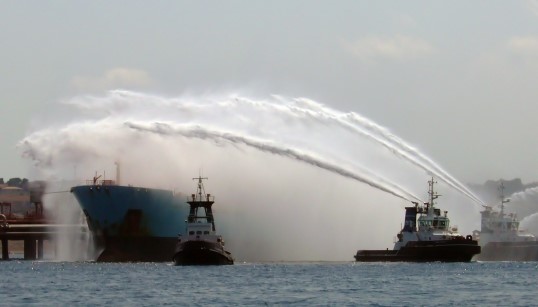- Topics
- Campaigning
- Careers
- Colleges
- Community
- Education and training
- Environment
- Equality
- Federation
- General secretary message
- Government
- Health and safety
- History
- Industrial
- International
- Law
- Members at work
- Nautilus news
- Nautilus partnerships
- Netherlands
- Open days
- Opinion
- Organising
- Podcasts from Nautilus
- Sponsored content
- Switzerland
- Technology
- Ukraine
- United Kingdom
- Welfare

The salvage industry faces a serious challenge from a reluctance on the part of insurers to sign up to the traditional contract arrangement, according to the latest International Salvage Union annual report. It's a potential threat to skilled seafarers in a sector that's vital for the marine environment and the safety of life at sea. Rob Coston reports.
In its 2019 Annual Report the International Salvage Union (ISU) has flagged an increasingly difficult business environment for its members, who have come under pressure in recent years from insurers reluctant to pay for ever more complex and costly salvage operations.
The traditional salvage industry model is under threat from non-traditional salvors, especially consultancies that put together and organise operations on behalf of insurers by hiring freelancers. There is even the challenge of new, cheaper players from China on the horizon. Operators who still have national contracts are being buoyed up, but governments are increasingly reluctant to pay subsidies to ensure that salvage tugs are kept on station.
This is causing a crisis of confidence among some operators, who are concerned about long-term prospects for the sector and worry that the industry's traditional payment model – the Lloyd's Open Form (LOF) – is breaking down. Last year, outgoing ISU president Charo Coll said that although the ISU will continue to promote LOF contracts, competition is causing salvors to use alternative arrangements that are not tailored for emergency salvage operations.
Perhaps it is no surprise that the two ISU members that left the organisation last year, Maridive and T&T Salvage, cited the difficult market conditions in salvage and the decision to pursue other business opportunities as their reasons for withdrawing.
The exit of specialist salvage businesses could undermine vessel safety and threaten the marine environment, the ISU warned in its Annual Review 2019. It could also put the lives of seafarers at risk.
According to the ISU, it is often only member firms that have the right equipment and expertise to meet the challenges of emergency salvage operations.
In 2019 ISU members provided 214 services to vessels carrying 2,308,756 tonnes of potentially polluting cargo and fuel. Some of these cases will have posed a severe threat to the marine environment.
ISU's incoming president Richard Janssen said it is essential that global provision of a professional salvage capability remains so that owners, insurers and wider society can have confidence that marine casualties will be safely and cleanly managed by contractors with the right skills, experience, people and equipment.
A lack of reputable, skilled and experienced salvors that can deliver services where and when they are needed could be the future crisis.
The value of salvage
Long-term trends continued to squeeze ISU members in 2019. Overall, there was a slight drop in the number of services provided and a slight gain in overall revenue thanks to increased wreck removal. Activity levels sank from 234 services in 2018 to 2014 in 2019.
The number of LOF contracts declined from 55 last year to just 35. LOF revenue halved from $104 million to a historic low of $49 million. Revenue from LOF cases represented 27% of all dry salvage (emergency response) revenue. SCOPIC revenue, awarded to salvors in cases where they prevent environmental damage in national waters, was the lowest in nearly 20 years at $17 million.
Wreck removal services buoyed overall revenues – up from 71 to 101 contracts – and income, up by $76 million to $284 million and now representing 59% of the total. It should be noted that large-scale wreck removal was also responsible for the higher revenues enjoyed by members in 2015 and earlier.
A lack of reputable, skilled and experienced salvors that can deliver services where and when they are needed could be the future crisis
Fit for purpose?
Steps are being taken to bolster the industry. The ISU has been working since 2018 to reposition the sector given the new business realities. The ultimate goal is to show stakeholders that members 'enable world trade by providing services which save life, protect the environment, mitigate risk and reduce loss', that doing this properly requires high standards, and to position the salvor as part of the 'risk mitigation chain'.
The ISU is also supporting efforts to make the tendering process for wreck removal more transparent and rigorous, an important step given the enormous financial risks involved.
ISU has consultative status at International Maritime Organization (IMO) and was involved with changes to the European Union Places of Refuge Guidelines which have now been submitted to the IMO Maritime Safety Committee with a revised wording to assist with IMO adoption as a world-wide standard.
Meanwhile, Lloyd's continues to promote LOF contracts and at the beginning of 2020 published revised editions of the contract and the associated procedural Lloyd's Salvage Arbitration Clauses (LSAC).
Whether the traditional business model can be repaired, however, remains to be seen. There are no clear figures for exactly how many seafarers work for ISU salvors but there are at least several hundred of them, and they all play a vital role for the public, industry, insurers and the planet. We can only hope that, whatever the outcome, the industry will remain strong enough to continue training and employing them so that they can provide their vital services globally.
Tags
